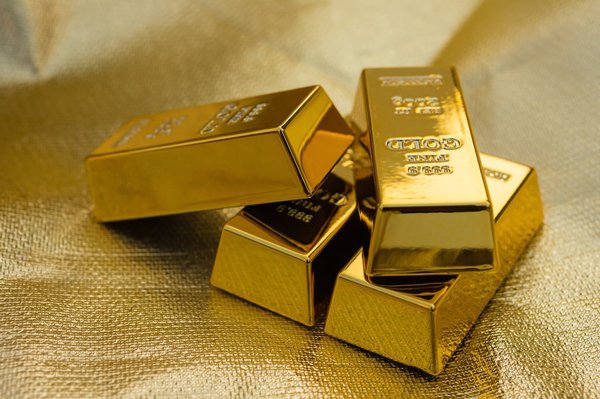There are a multitude of ways to invest in gold. You can buy physical gold in the form of jewelry, bullion, and coins; buy shares of a gold mining company or other gold-related investment; or purchase something that derives its value from gold. Each method has its benefits and drawbacks. That can make it daunting for beginning investors to know the best way to gain exposure to this precious metal.
This guide will help you start investing money in the gold market. We'll explore all the ways you can invest in gold and discuss their pros and cons so you can learn more about how to invest in gold.

Ways to invest in gold
Ways to invest in gold
The following table shows the many ways you can invest in gold:
| Gold Investing Method | Description | Pros | Cons |
|---|---|---|---|
| Gold jewelry | Jewelry like rings, necklaces, and bracelets made with gold. |
-Easy to acquire -Has value to the acquirer |
-High markups -Questionable resale value |
| Gold bullion | Gold formed into bars or ingots. |
-Direct exposure to the price of gold -Tangible ownership |
-High costs for storage and insurance -No upside beyond gold price changes -Fairly illiquid |
| Gold coins | Coins made from gold. |
-Direct exposure to the price of gold -Tangible ownership |
-High markups -No upside beyond gold price changes -Cost of storage -Fairly illiquid |
| Gold stocks | Equity ownership in a publicly traded gold mining, streaming, or royalty company. |
-Upside to the price of gold from production growth -Potential to earn dividend income |
-Risk of underperforming the price of gold -Exposure to other commodities |
| Gold certificates | Proves ownership of a specific amount of gold. |
-Direct exposure to the price of gold -No need to own physical gold |
-Only as good as the company that backs them -Only a few companies issue them -Largely illiquid |
| Gold ETFs and mutual funds | Exchange-traded funds (ETFs) and mutual funds that own physical gold bullion or shares of gold mining stocks. |
-Highly liquid -Diversified exposure -Upside potential |
-Management fees -Risks underperforming the price of gold |
| Gold futures and options | Derivative contracts that provide exposure to the price of gold. |
-Direct exposure to the price of gold -No need to own physical gold |
-Highly risky -Potentially costly to roll contracts forward |
Here's a closer look at these gold investment methods.
Gold jewelry
Buying gold jewelry is an indirect way to invest in gold. However, jewelry tends to hold more value for the wearer than an investment due to the markup of turning the precious metal into jewelry and then selling it in the retail market. Expensive gold jewelry may retain its value, although that's often more due to its value as a collector's item than its gold content. Another downside to jewelry as a gold investment is the cost of storage and insurance. It's also not a liquid investment since you can't easily sell it at market value.
Gold bullion
Bullion is pure gold (99.5% to 99.9%) formed into bars or ingots, typically rectangular shapes that allow for easier storage. Central banks often keep gold bullion as a reserve asset, storing it in vaults. Gold bullion gives investors direct exposure to the price of gold. However, it's expensive. With the price of gold around $2,000 per ounce in early 2022, a bar would be prohibitively expensive; an ingot would also cost a lot, depending on its size. In addition to the cost of purchasing a gold bar or ingot, an investor would also need to pay for storage and insurance on their gold investment. Gold bullion also isn't a very liquid investment.
Gold coins
Gold coins have a long history as a currency. While they aren't legal tender anymore, gold coins still hold value to investors as a store of value. There are costs associated with purchasing, storing, and insuring gold coins, which can affect their performance. Meanwhile, they aren't very liquid since you'd need to find a collector or other buyer willing to purchase the coins from you.
Gold stocks
Gold stocks include companies focused on exploring and mining for gold. They also include gold streaming companies and royalty companies.
Gold miners provide investors with the most upside potential. They can make investments to expand their production (e.g., develop new mines, expand existing ones, and acquire another gold miner) that can enable them to outperform the price of gold. They can also pay a dividend, providing investors with a gold-driven income stream. Gold stocks are highly liquid since investors can easily buy and sell them in a brokerage account.
However, there are risks associated with gold miners. Cost overruns, mismanagement, and excessive debt can cause a gold mining stock to underperform the price of gold. In addition, many mine other materials, including precious metals such as silver or other metals such as copper. Although the diversification reduces risk, it potentially dilutes the impact of rising gold prices.
Meanwhile, gold streaming and royalty companies provide capital to gold miners to develop and expand mines. They either receive the right to purchase gold at a fixed price (streamers) or a portion of the gold revenue (royalties), reducing their risk compared to gold mining stocks.
Related investing topics
Gold certificates
Gold certificates are notes issued by a company that prove ownership of the stated amount of gold. Once issued by the U.S. government as a currency equivalent, some banks and investment companies still issue gold certificates that give the holder ownership of a portion of their gold holdings. Gold certificates give investors direct exposure to the price of gold. However, they're only as safe as the underlying company issuing the certificate. If the company goes bankrupt, the gold certificate can become worthless.
Exchange-Traded Fund (ETF)
ETFs and mutual funds
Gold ETFs and mutual funds
Gold ETFs focus on owning physical gold or shares of gold mining companies, creating different risk profiles. An ETF focused on owning physical gold bars offers investors direct exposure to the price of gold. They tend to match the price movement of gold relatively well. However, ETFs come at a cost in the form of an ETF expense ratio. The cost can be worth it, though, since gold ETFs are often the easiest way to invest in gold. They're also highly liquid.
Gold stock ETFs and mutual funds typically own shares of several gold miners. The diversification gives investors broad exposure to the gold mining segment, which helps reduce risk. Gold stock ETFs and mutual funds provide investors with upsides beyond the price of gold. However, the downside of gold mining ETFs and mutual funds is that they generally underperform the price of gold.
Futures and options
Gold futures and options
A futures contract gives the holder the right to buy a specific amount of gold at a future date and price. Options contracts also enable the holder to buy or sell shares of a gold ETF or gold mining stock at a specific price and date. The contracts move with the underlying price of gold or the shares of the gold-related equity, giving the investor exposure to gold without owning the underlying investment.
One downside to gold futures and options contracts is leverage. Investors don't need to put the full value down at purchase. The leverage can increase an investor's gains but also can cause losses, especially if the holder doesn't have enough capital to satisfy the purchase. Insufficient capital can force investors to sell at a loss instead of purchasing to hold for a potential future recovery.
The bottom line on investing in gold
There are many ways to invest in gold, and each has its pros and cons. While investors should weigh each option to determine the best method for their circumstances and risk tolerance, gold price ETFs and gold streaming and royalty companies tend to be ideal options for beginning gold investors. They offer lower downside risk compared to other options. They also tend to match the price performance of gold (or beat it, in the case of streaming and royalty companies). That helps investors seeking gold's safety and inflation protection to benefit from a gold investment with more liquidity than a physical gold investment.
FAQs
Gold investing FAQs
How is the price of gold determined?
Many factors affect the price of gold. These include demand for the metal in making jewelry, for some technology applications, and for investment purposes. Other factors, such as the amount of gold in central bank reserves, the value of the U.S. dollar, and the desire by investors to hold gold as a hedge against inflation or currency devaluation, help to drive its price.
When should you buy gold?
Many investors see gold as a good hedge against rising prices and a store of value. It has also historically been a strong hedge during times of financial crisis. The best times to buy gold are when concerns about inflation or economic crisis are beginning to surface since gold tends to rise during those periods.
How much should you invest in gold?
There's a lot of debate about how much gold an investor should have in their portfolio. Many investors don't hold any gold, while others will make it a significant portion of their portfolio. However, as part of a diversified portfolio, a general rule would be to limit gold's percentage of your portfolio to 5% to 10% of the total account value.









